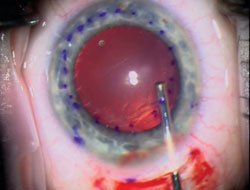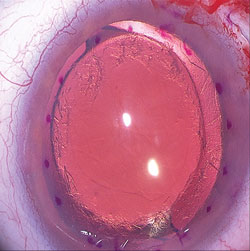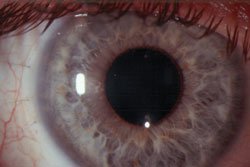DSAEK with peripheral scraping helps to eliminate dislocations
This technique promotes donor tissue adhesion along the graft edges.
Introduction
 Thomas John |
Corneal transplantation began with lamellar keratoplasty, then moved to penetrating keratoplasty, and it has now moved to a lamellar procedure called Descemet’s stripping automated endothelial keratoplasty. This milestone change brings improved vision, elimination of full-thickness corneal wound and corneal sutures, faster visual recovery, improved quality of vision and, therefore, improved quality of life. Such a procedure is called selective tissue corneal transplantation.
However, with new and improved surgical techniques come new difficulties and hurdles, and one such hurdle is disc detachment after DSAEK. Various authors have described techniques to try to overcome this complication by making corneal slits and using large air bubbles and new instrumentations.
In this column, Dr. Mark Terry takes advantage of what we have learned from deep lamellar endothelial keratoplasty (DLEK), a forerunner of the DSAEK procedure, and describes his technique of corneal stromal scraping to increase donor corneal adhesion to the recipient cornea.
– Thomas John, MD
OSN Surgical Maneuvers
Editor
 Mark A. Terry |
The most common postoperative complication after DSAEK is donor disc dislocation into the anterior chamber. While techniques utilized by some excellent surgeons have reported a dislocation rate as high as 23% and a primary graft failure rate of 17% in their first 118 cases, the technique we have utilized yielded a dislocation rate of only 1.8% over our first 500 DSAEK cases with no primary graft failure.
Early graft adherence is essential until the donor endothelium becomes fully functional and wound healing can provide permanent attachment of the donor tissue. It can take 24 hours or longer until the endothelial pump mechanism comes fully into play for graft adherence. We have designed the benign maneuver of scraping the peripheral recipient bed in DSAEK to promote donor tissue adhesion along the graft edges. With peripheral scraping, we do not need a large air bubble and often leave just a 5-mm or smaller air bubble at the end of surgery.
Surgical technique
In our DSAEK technique, we create an adhesive quality of the recipient bed (similar to DLEK) by scraping the peripheral bed immediately after stripping Descemet’s membrane (Figures 1 to 5). Both the stripping of Descemet’s and the scraping of the stroma are easily done with cohesive viscoelastic filling the anterior chamber. The viscoelastic is removed with an irrigation and aspiration cannula, and the tissue is inserted in our usual fashion.
 Figure 1. Stripping of Descemet’s with a blunt reverse Sinskey hook with Healon filling the anterior chamber. |
 Figure 2. Terry scraper seen in profile above the eye. Note 1-mm wide semi-sharp scraping head. Images: Terry MA |
 Figure 3. Scraping of the peripheral recipient bed with a Terry scraper. Note obvious white stromal fibrils band that is created. |
 Figure 4. Completed band of peripheral recipient bed scraping, 360°. Note that stromal fibrils of band are not subtle. |
The visual confirmation of appropriate peripheral scraping is the obvious intraoperative appearance of a 1-mm band of white stromal fibers (Figures 3 and 4). This band is not subtle. Creation of the band must be done with a true scraping device and not by blunt instruments such as a Sinskey hook or a Melles stripper. A sharp needle could be used, but this would take a long time to create a wide enough band for adhesion. We use a 1-mm wide Terry scraper (Bausch & Lomb Surgical) (Figures 2 and 3), but there are many other DSAEK scraper instruments on the market that should work as well.
|
|
It is important that the scraping should be done aggressively over the stripped peripheral recipient bed, leaving the central 6 mm or more of central bed untouched for excellent vision. It is more common to “under-scrape” than to “over-scrape.” We scrape all DSAEK cases, namely, Fuchs’ dystrophy, pseudophakic bullous keratopathy, failed PK grafts or other cause of endothelial dysfunction. In eyes with a failed PK, care is taken to keep the stripping and then scraping the recipient bed entirely central to the posterior vertical healed wound of the PK in order to avoid dehiscence of the PK posterior wound.
We have not experienced any downside to peripheral scraping. The maneuver only adds 2 or 3 minutes to the procedure, it is easy to perform, and at 6 weeks postoperatively, the areas of scraping are invisible to slit-lamp examination (Figure 5) with no effect on visual acuity.
Peripheral scraping of the recipient bed can be an effective means of temporary attachment of the donor tissue to the overlying recipient bed until permanent attachment is accomplished by wound healing and the endothelium. Experienced surgeons have reported a high dislocation rate (more than 20%) before using scraping and before attending our DSAEK course in Portland. After adding scraping and other steps to their DSAEK technique, they have reported to us dislocation rates below 5%. Obviously, grafts can stay attached in DSAEK surgery without peripheral scraping, but when this one benign step is added (and endothelial trauma is minimized), the dislocations can be nearly eliminated.
References:
- John T. Corneal Endothelial Transplant (DSAEK, DMEK, & DLEK). New Delhi, India: Jaypee Brothers Medical Publishers; 2010.
- John T. Lamellar Corneal Surgery. New York: McGraw-Hill Companies; 2008.
- John T. Selective tissue corneal transplantation: a great step forward in global visual restoration. Expert Rev Ophthalmol. 2006;1:5-7.
- Suh LH, Yoo SH, Deobhakta A, et al. Complications of Descemet’s stripping with automated endothelial keratoplasty: Survey of 118 eyes at one institute. Ophthalmology. 2008;115(9):1517-1524.
- Terry MA, Hoar KL, Wall J, Ousley P. Histology of dislocations in endothelial keratoplasty (DSEK and DLEK): a laboratory-based, surgical solution to dislocation in 100 consecutive DSEK cases. Cornea. 2006;25(8):926-932.
- Terry MA, Shamie N, Chen ES, et al. Endothelial keratoplasty for Fuchs’ dystrophy with cataract: complications and clinical results with the new triple procedure. Ophthalmology. 2009;116(4):631-639.
- Terry MA, Shamie N, Chen ES, Hoar KL, Friend DJ. Endothelial keratoplasty a simplified technique to minimize graft dislocation, iatrogenic graft failure, and pupillary block. Ophthalmology. 2008;115(7):1179-1186.
- Thomas John, MD, is a clinical associate professor at Loyola University at Chicago and is in private practice in Tinley Park and Oak Lawn, Ill. He can be reached at 708-429-2223; fax: 708-429-2226; e-mail: tjcornea@gmail.com.
- Mark A. Terry, MD, can be reached at Devers Eye Institute, 1040 NW 22nd Ave., Suite 200, Portland, OR 97210-3065; 503-413-6223; fax: 503-413-6937; e-mail: mterry@deverseye.org.


